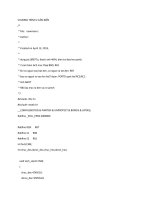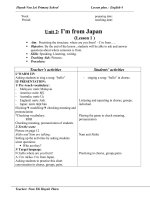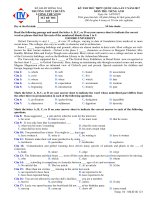- Trang chủ >>
- Sư phạm >>
- Sư phạm toán
(Princeton lectures in analysis, 2) elias m stein, rami shakarchi complex analysis (princeton lectures in analysis, volume ii) princeton university press (2003)
Bạn đang xem bản rút gọn của tài liệu. Xem và tải ngay bản đầy đủ của tài liệu tại đây (3.43 MB, 398 trang )
COMPLEX ANALYSIS
Princeton Lectures in Analysis
I Fourier Analysis: An Introduction
II Complex Analysis
III Real Analysis:
Measure Theory, Integration, and
Hilbert Spaces
Princeton Lectures in Analysis
II
COMPLEX ANALYSIS
Elias M. Stein
&
Rami Shakarchi
PRINCETON UNIVERSITY PRESS
PRINCETON AND OXFORD
Copyright © 2003 by Princeton University Press
Published by Princeton University Press, 41 William Street,
Princeton, New Jersey 08540
In the United Kingdom: Princeton University Press,
6 Oxford Street, Woodstock, Oxfordshire OX20 1TW
All Rights Reserved
Library of Congress Control Number 2005274996
ISBN 978-0-691-11385-2
British Library Cataloging-in-Publication Data is available
The publisher would like to acknowledge the authors of this volume for
providing the camera-ready copy from which this book was printed
Printed on acid-free paper. ∞
press.princeton.edu
Printed in the United States of America
5 7 9 10 8 6
To my grandchildren
Carolyn, Alison, Jason
E.M.S.
To my parents
Mohamed & Mireille
and my brother
Karim
R.S.
Foreword
Beginning in the spring of 2000, a series of four one-semester courses
were taught at Princeton University whose purpose was to present, in
an integrated manner, the core areas of analysis. The objective was to
make plain the organic unity that exists between the various parts of the
subject, and to illustrate the wide applicability of ideas of analysis to
other fields of mathematics and science. The present series of books is
an elaboration of the lectures that were given.
While there are a number of excellent texts dealing with individual
parts of what we cover, our exposition aims at a different goal: pre-
senting the various sub-areas of analysis not as separate disciplines, but
rather as highly interconnected. It is our view that seeing these relations
and their resulting synergies will motivate the reader to attain a better
understanding of the subject as a whole. With this outcome in mind, we
have concentrated on the main ideas and theorems that have shaped the
field (sometimes sacrificing a more systematic approach), and we have
been sensitive to the historical order in which the logic of the subject
developed.
We have organized our exposition into four volumes, each reflecting
the material covered in a semester. Their contents may be broadly sum-
marized as follows:
I. Fourier series and integrals.
II. Complex analysis.
III. Measure theory, Lebesgue integration, and Hilbert spaces.
IV. A selection of further topics, including functional analysis, distri-
butions, and elements of probability theory.
However, this listing does not by itself give a complete picture of
the many interconnections that are presented, nor of the applications
to other branches that are highlighted. To give a few examples: the ele-
ments of (finite) Fourier series studied in Book I, which lead to Dirichlet
characters, and from there to the infinitude of primes in an arithmetic
progression; the X-ray and Radon transforms, which arise in a number of
vii
viii FOREWORD
problems in Book I, and reappear in Book III to play an important role in
understanding Besicovitch-like sets in two and three dimensions; Fatou’s
theorem, which guarantees the existence of boundary values of bounded
holomorphic functions in the disc, and whose proof relies on ideas devel-
oped in each of the first three books; and the theta function, which first
occurs in Book I in the solution of the heat equation, and is then used
in Book II to find the number of ways an integer can be represented as
the sum of two or four squares, and in the analytic continuation of the
zeta function.
A few further words about the books and the courses on which they
were based. These courses where given at a rather intensive pace, with 48
lecture-hours a semester. The weekly problem sets played an indispens-
able part, and as a result exercises and problems have a similarly im-
portant role in our books. Each chapter has a series of “Exercises” that
are tied directly to the text, and while some are easy, others may require
more effort. However, the substantial number of hints that are given
should enable the reader to attack most exercises. There are also more
involved and challenging “Problems”; the ones that are most difficult, or
go beyond the scope of the text, are marked with an asterisk.
Despite the substantial connections that exist between the different
volumes, enough overlapping material has been provided so that each of
the first three books requires only minimal prerequisites: acquaintance
with elementary topics in analysis such as limits, series, differentiable
functions, and Riemann integration, together with some exposure to lin-
ear algebra. This makes these books accessible to students interested
in such diverse disciplines as mathematics, physics, engineering, and
finance, at both the undergraduate and graduate level.
It is with great pleasure that we express our appreciation to all who
have aided in this enterprise. We are particularly grateful to the stu-
dents who participated in the four courses. Their continuing interest,
enthusiasm, and dedication provided the encouragement that made this
project possible. We also wish to thank Adrian Banner and Jose Luis
Rodrigo for their special help in running the courses, and their efforts to
see that the students got the most from each class. In addition, Adrian
Banner also made valuable suggestions that are incorporated in the text.
FOREWORD ix
We wish also to record a note of special thanks for the following in-
dividuals: Charles Fefferman, who taught the first week (successfully
launching the whole project!); Paul Hagelstein, who in addition to read-
ing part of the manuscript taught several weeks of one of the courses, and
has since taken over the teaching of the second round of the series; and
Daniel Levine, who gave valuable help in proof-reading. Last but not
least, our thanks go to Gerree Pecht, for her consummate skill in type-
setting and for the time and energy she spent in the preparation of all
aspects of the lectures, such as transparencies, notes, and the manuscript.
We are also happy to acknowledge our indebtedness for the support
we received from the 250th Anniversary Fund of Princeton University,
and the National Science Foundation’s VIGRE program.
Elias M. Stein
Rami Shakarchi
Princeton, New Jersey
August 2002
Contents
Foreword vii
Introduction xv
Chapter 1. Preliminaries to Complex Analysis 1
1 Complex numbers and the complex plane 1
1.1 Basic properties 1
1.2 Convergence 5
1.3 Sets in the complex plane 5
2 Functions on the complex plane 8
2.1 Continuous functions 8
2.2 Holomorphic functions 8
2.3 Power series 14
3 Integration along curves 18
4 Exercises 24
Chapter 2. Cauchy’s Theorem and Its Applications 32
1 Goursat’s theorem 34
2 Local existence of primitives and Cauchy’s theorem in a
disc 37
3 Evaluation of some integrals 41
4 Cauchy’s integral formulas 45
5 Further applications 53
5.1 Morera’s theorem 53
5.2 Sequences of holomorphic functions 53
5.3 Holomorphic functions defined in terms of integrals 55
5.4 Schwarz reflection principle 57
5.5 Runge’s approximation theorem 60
6 Exercises 64
7 Problems 67
Chapter 3. Meromorphic Functions and the Logarithm 71
1 Zeros and poles 72
2 The residue formula 76
2.1 Examples 77
3 Singularities and meromorphic functions 83
4 The argument principle and applications 89
xi
xii CONTENTS
5 Homotopies and simply connected domains 93
6 The complex logarithm 97
7 Fourier series and harmonic functions 101
8 Exercises 103
9 Problems 108
Chapter 4. The Fourier Transform 111
1 The class F 113
2 Action of the Fourier transform on F 114
3 Paley-Wiener theorem 121
4 Exercises 127
5 Problems 131
Chapter 5. Entire Functions 134
1 Jensen’s formula 135
2 Functions of finite order 138
3 Infinite products 140
3.1 Generalities 140
3.2 Example: the product formula for the sine function 142
4 Weierstrass infinite products 145
5 Hadamard’s factorization theorem 147
6 Exercises 153
7 Problems 156
Chapter 6. The Gamma and Zeta Functions 159
1 The gamma function 160
1.1 Analytic continuation 161
1.2 Further properties of Γ 163
2 The zeta function 168
2.1 Functional equation and analytic continuation 168
3 Exercises 174
4 Problems 179
Chapter 7. The Zeta Function and Prime Number The-
orem 181
1 Zeros of the zeta function 182
1.1 Estimates for 1/ζ(s) 187
2 Reduction to the functions ψ and ψ1 188
2.1 Proof of the asymptotics for ψ1 194
Note on interchanging double sums 197
3 Exercises 199
CONTENTS xiii
4 Problems 203
Chapter 8. Conformal Mappings 205
1 Conformal equivalence and examples 206
1.1 The disc and upper half-plane 208
1.2 Further examples 209
1.3 The Dirichlet problem in a strip 212
2 The Schwarz lemma; automorphisms of the disc and upper
half-plane 218
2.1 Automorphisms of the disc 219
2.2 Automorphisms of the upper half-plane 221
3 The Riemann mapping theorem 224
3.1 Necessary conditions and statement of the theorem 224
3.2 Montel’s theorem 225
3.3 Proof of the Riemann mapping theorem 228
4 Conformal mappings onto polygons 231
4.1 Some examples 231
4.2 The Schwarz-Christoffel integral 235
4.3 Boundary behavior 238
4.4 The mapping formula 241
4.5 Return to elliptic integrals 245
5 Exercises 248
6 Problems 254
Chapter 9. An Introduction to Elliptic Functions 261
1 Elliptic functions 262
1.1 Liouville’s theorems 264
1.2 The Weierstrass ℘ function 266
2 The modular character of elliptic functions and Eisenstein
series 273
2.1 Eisenstein series 273
2.2 Eisenstein series and divisor functions 276
3 Exercises 278
4 Problems 281
Chapter 10. Applications of Theta Functions 283
1 Product formula for the Jacobi theta function 284
1.1 Further transformation laws 289
2 Generating functions 293
3 The theorems about sums of squares 296
3.1 The two-squares theorem 297
xiv CONTENTS
3.2 The four-squares theorem 304
4 Exercises 309
5 Problems 314
Appendix A: Asymptotics 318
1 Bessel functions 319
2 Laplace’s method; Stirling’s formula 323
3 The Airy function 328
4 The partition function 334
5 Problems 341
Appendix B: Simple Connectivity and Jordan Curve
Theorem 344
1 Equivalent formulations of simple connectivity 345
2 The Jordan curve theorem 351
2.1 Proof of a general form of Cauchy’s theorem 361
Notes and References 365
Bibliography 369
Symbol Glossary 373
Index 375
Introduction
... In effect, if one extends these functions by allowing
complex values for the arguments, then there arises
a harmony and regularity which without it would re-
main hidden.
B. Riemann, 1851
When we begin the study of complex analysis we enter a marvelous
world, full of wonderful insights. We are tempted to use the adjectives
magical, or even miraculous when describing the first theorems we learn;
and in pursuing the subject, we continue to be astonished by the elegance
and sweep of the results.
The starting point of our study is the idea of extending a function
initially given for real values of the argument to one that is defined when
the argument is complex. Thus, here the central objects are functions
from the complex plane to itself
f : C → C,
or more generally, complex-valued functions defined on open subsets of C.
At first, one might object that nothing new is gained from this extension,
since any complex number z can be written as z = x + iy where x, y ∈ R
and z is identified with the point (x, y) in R2.
However, everything changes drastically if we make a natural, but
misleadingly simple-looking assumption on f : that it is differentiable
in the complex sense. This condition is called holomorphicity, and it
shapes most of the theory discussed in this book.
A function f : C → C is holomorphic at the point z ∈ C if the limit
lim f (z + h) − f (z) (h ∈ C)
h→0 h
exists. This is similar to the definition of differentiability in the case of
a real argument, except that we allow h to take complex values. The
reason this assumption is so far-reaching is that, in fact, it encompasses
a multiplicity of conditions: so to speak, one for each angle that h can
approach zero.
xv
xvi INTRODUCTION
Although one might now be tempted to prove theorems about holo-
morphic functions in terms of real variables, the reader will soon discover
that complex analysis is a new subject, one which supplies proofs to the
theorems that are proper to its own nature. In fact, the proofs of the
main properties of holomorphic functions which we discuss in the next
chapters are generally very short and quite illuminating.
The study of complex analysis proceeds along two paths that often
intersect. In following the first way, we seek to understand the univer-
sal characteristics of holomorphic functions, without special regard for
specific examples. The second approach is the analysis of some partic-
ular functions that have proved to be of great interest in other areas of
mathematics. Of course, we cannot go too far along either path without
having traveled some way along the other. We shall start our study with
some general characteristic properties of holomorphic functions, which
are subsumed by three rather miraculous facts:
1. Contour integration: If f is holomorphic in Ω, then for appro-
priate closed paths in Ω
f (z)dz = 0.
γ
2. Regularity: If f is holomorphic, then f is indefinitely differen-
tiable.
3. Analytic continuation: If f and g are holomorphic functions
in Ω which are equal in an arbitrarily small disc in Ω, then f = g
everywhere in Ω.
These three phenomena and other general properties of holomorphic
functions are treated in the beginning chapters of this book. Instead
of trying to summarize the contents of the rest of this volume, we men-
tion briefly several other highlights of the subject.
• The zeta function, which is expressed as an infinite series
∞1
ζ(s) = ns ,
n=1
and is initially defined and holomorphic in the half-plane Re(s) > 1,
where the convergence of the sum is guaranteed. This function
and its variants (the L-series) are central in the theory of prime
numbers, and have already appeared in Chapter 8 of Book I, where
INTRODUCTION xvii
we proved Dirichlet’s theorem. Here we will prove that ζ extends to
a meromorphic function with a pole at s = 1. We shall see that the
behavior of ζ(s) for Re(s) = 1 (and in particular that ζ does not
vanish on that line) leads to a proof of the prime number theorem.
• The theta function
∞
Θ(z|τ ) = eπin2τ e2πinz ,
n=−∞
which in fact is a function of the two complex variables z and τ ,
holomorphic for all z, but only for τ in the half-plane Im(τ ) > 0.
On the one hand, when we fix τ , and think of Θ as a function of
z, it is closely related to the theory of elliptic (doubly-periodic)
functions. On the other hand, when z is fixed, Θ displays features
of a modular function in the upper half-plane. The function Θ(z|τ )
arose in Book I as a fundamental solution of the heat equation on
the circle. It will be used again in the study of the zeta function, as
well as in the proof of certain results in combinatorics and number
theory given in Chapters 6 and 10.
Two additional noteworthy topics that we treat are: the Fourier trans-
form with its elegant connection to complex analysis via contour integra-
tion, and the resulting applications of the Poisson summation formula;
also conformal mappings, with the mappings of polygons whose inverses
are realized by the Schwarz-Christoffel formula, and the particular case
of the rectangle, which leads to elliptic integrals and elliptic functions.
1 Preliminaries to Complex
Analysis
The sweeping development of mathematics during the
last two centuries is due in large part to the introduc-
tion of complex numbers; paradoxically, this is based
on the seemingly absurd notion that there are num-
bers whose squares are negative.
E. Borel, 1952
This chapter is devoted to the exposition of basic preliminary material
which we use extensively throughout of this book.
We begin with a quick review of the algebraic and analytic properties
of complex numbers followed by some topological notions of sets in the
complex plane. (See also the exercises at the end of Chapter 1 in Book I.)
Then, we define precisely the key notion of holomorphicity, which is
the complex analytic version of differentiability. This allows us to discuss
the Cauchy-Riemann equations, and power series.
Finally, we define the notion of a curve and the integral of a function
along it. In particular, we shall prove an important result, which we state
loosely as follows: if a function f has a primitive, in the sense that there
exists a function F that is holomorphic and whose derivative is precisely
f , then for any closed curve γ
f (z) dz = 0.
γ
This is the first step towards Cauchy’s theorem, which plays a central
role in complex function theory.
1 Complex numbers and the complex plane
Many of the facts covered in this section were already used in Book I.
1.1 Basic properties
A complex number takes the form z = x + iy where x and y are real,
and i is an imaginary number that satisfies i2 = −1. We call x and y the









